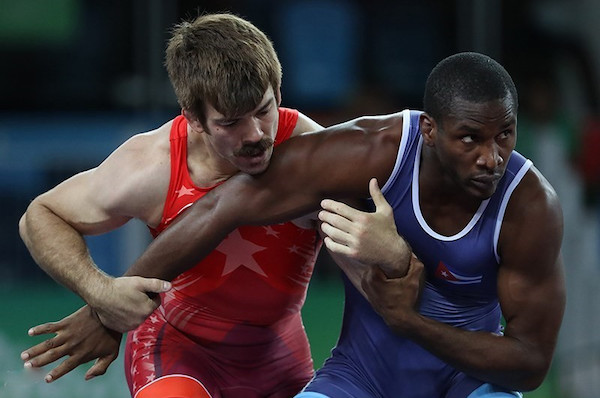
Do you have some questions about the Russian tie?
In this article, we’ll look at what the Russian tie is, how it’s performed, its history, as well as what a Russian tie snap is, how it’s performed, Russian tie takedowns, and more.
Contents
What Is the Russian Tie?
The Russian tie, also known as the two-on-one, is a technique used in wrestling to control an opponent’s arm.
The idea is to control one of the opponent’s arms with both arms, thereby limiting their offensive capabilities and setting up various offensive moves such as throws, takedowns, or transitions to other control positions.
In fact, for many practitioners, the purpose of the Russian tie is to drain the energy of the opponent as well as drain the clock – especially when they’re ahead on the scoreboard.
The Russian tie is achieved by gripping the opponent’s wrist with one hand and their upper arm with an underhook from the back and as close to the armpit as possible, effectively tying up that arm and limiting the opponent’s ability to attack or defend.
This grappling maneuver is a staple in freestyle and Greco-Roman wrestling, as well as in judo, sambo, submission wrestling, Brazilian jiu-jitsu, and mixed martial arts, albeit less commonly in the latter.
How To Do the Russian Tie
The Russian tie is a nuanced technique requiring a combination of grip strength, body positioning, and leverage.
Here’s a step-by-step guide to help you secure a Russian tie effectively:
1. Adopt a Proper Stance
Start in a solid wrestling stance with your feet shoulder-width apart, knees slightly bent, and weight evenly distributed.
Keep your head up and your core engaged.
2. Initiate Contact
Engage with your opponent and look for an opportunity to control their leading arm. This often comes from a feint or when they reach out to grab you.
3. Secure the Wrist
With the hand closest to your opponent’s leading arm, firmly grasp their wrist.
Your grip should be strong and precise, preventing them from easily slipping away.
4. Establish the Underhook
Use your other hand to underhook your opponent’s arm as close to the armpit as possible.
The deeper the underhook, the more control you will have over their arm.
5. Clamp Down
Once you have the underhook, clamp your elbow down towards your own ribcage.
This secures their arm tightly to your body and gives you greater control.
6. Apply Pressure
Pull their wrist towards you while pushing the elbow up and in with your underhook.
This dual pressure not only off-balances your opponent but also prevents them from using that arm effectively.
7. Maintain Control
Keep your own body tight and compact.
Use your head to pressure their head, which adds another layer of control and can further off-balance them.
The opponent’s main defense will be to regain head control, so this position is vital.
8. Execute Follow-Up Techniques
With the Russian tie secured, you can now look for follow-up techniques such as takedowns, throws, or transitions to other holds, depending on your opponent’s reaction and your game plan.
9. Drill Consistently
Practice the Russian tie regularly with a partner, focusing on smooth transitions into the hold and follow-up techniques.
Consistent drilling will improve your muscle memory and execution under live conditions.
Note: Remember, the effectiveness of the Russian tie comes from your ability to control your opponent’s arm and use it to dictate the pace and flow of the match.
The closer you are to their armpit with your underhook, the more leverage you will have, making it a powerful tool in your wrestling arsenal.
For further clarification, here’s a superb video demonstrating how to do the Russian Tie:
Russian Tie Origin
The Russian tie, known for its strategic use of leverage and technique, is deeply rooted in the traditional wrestling styles of Russia and the former Soviet Union.
Originating from martial arts such as Khapsagay, Tatar Köräş, and Kurash, the Russian tie was distinctly refined and brought to the forefront of combat sports in the 20th century.
This period, particularly marked by the development of Soviet wrestling dominance and the establishment of sambo in the 1920s and 1930s, saw the technique gain international recognition and adoption.
As a fundamental component of the Soviet wrestling repertoire, the Russian tie was honed to perfection and showcased in international competitions, capturing the attention of the global martial arts community.
Its effectiveness in these arenas led to its incorporation into the emerging martial art of sambo, and more recently in judo, Brazilian jiu-jitsu, and MMA.
Despite the adaptations made to fit the unique demands and regulations of each sport, the essence of the Russian tie – its emphasis on control and the economical use of force – has remained the same.
What Is the Russian Tie Snap?
After securing a Russian tie, a Russian Tie snap is a technique where the practitioner uses a snapping motion to aggressively pull the opponent’s arm down, across, and towards them.
The Russian tie snap is designed to off-balance the opponent quickly and create openings for attacks.
The snap can also be used to transition into other techniques or to force the opponent to the mat, where back control is often sought after.
Russian wrestler Aniuar Geduev is credited with coming up with the ankle pick and Russian tie snap tactic.
He uses the Russian tie snap to pull the opponent downward and the ankle pick to push them away, creating additional rotational force.
He effectively used it during his multiple gold medal successes at the European Wrestling Championships in 2013 and 2014, as well as during many other championships.
How To Do the Russian Tie Snap
Here’s how to do the Russian tie snap, step by step.
1. Establish Wrist Control
Begin by obtaining a firm grip on your opponent’s wrist. This grip is the anchor of your control and the pivot for the snap.
2. Create a Lower Body Threat
Threaten a low single-leg takedown or ankle pick on the leg opposite the wrist you’re controlling. If you have their right wrist, feint towards their left leg.
This threat should be convincing enough to make your opponent react defensively.
3. Shift Their Weight
As your opponent reacts to your lower body threat, they will instinctively shift their weight away from their feet and forward towards their hands to defend against the takedown.
This shift may cause them to balance on one foot, destabilizing their base momentarily.
This momentary imbalance is what you’re looking for to execute the snap.
4. Execute the Snap
With your opponent’s weight shifted forward and their base compromised, sharply and forcefully pull their wrist down and across their body to exploit their unstable position.
5. Take Advantage of the Fall
As your opponent falls forward or hits the ground, quickly take their back or transition to another dominant position.
Tips for Effectiveness
- Distraction: A tap on the back of their head can be a distraction if you have a collar tie, setting up a more successful snap.
- Leg Control: If you can grab the foot or ankle during your feint, use it to push the opponent away as you pull the wrist down and across, creating additional rotational force.
- Timing the Pull: Execute the pull just before their hand touches the ground, capitalizing on their forward momentum and making it difficult for them to recover balance.
For further clarification, here’s a video showing UFC champion Islam Makhachev executing the perfect Russian tie snap, where he uses the tap distraction:
Russian Tie Takedowns
The Russian tie is a versatile grip that sets up a variety of takedowns, each exploiting the control and imbalance created by the two-on-one arm control.
Here are some common takedowns that can be executed from a Russian tie:
Russian Tie Snap: As previously described, this move involves snapping the opponent’s arm down and across their body to off-balance and bring them down to the mat, potentially allowing you to take their back.
Inside Trip: With control of the arm, you can step inside your opponent’s stance and use your leg to trip them over your own. This is often done by stepping in close to disrupt their balance before executing the trip.
Ankle Pick: From the Russian tie, you can lower your level and reach for the opponent’s far ankle, using the arm control to pull them forward as you pick the ankle to bring them down.
Arm Drag to Single or Double Leg: Using the Russian tie, you can perform an arm drag to expose your opponent’s side, allowing you to transition to a single or double leg takedown.
Throw-By: This technique involves using the Russian tie to pull and push the opponent’s arm by you, creating an opening to attack their back or set up further leg attacks.
High Crotch or Fireman’s Carry: With the opponent’s arm controlled, you can transition to a high crotch or fireman’s carry by dropping to your knees and lifting them off the ground, using the momentum to execute the takedown.
Here’s the Russian Tie to Double Leg by Sergei Beloglazov, a two-time Olympic Champion and six-time World Champion in wrestling:
Frequently Asked Questions
Why Is It Called a Russian Tie?
The technique is called a Russian tie because it’s associated with the traditional wrestling styles of Russia and the former Soviet Union.
It became widely known as the “Russian tie” in the wrestling and martial arts communities outside of Russia due to its effective use by Soviet wrestlers in international competitions during the 20th century.
What Is a Russian 2-on-1?
The Russian 2-on-1 is another name for the Russian tie, which is a grip or control position used in wrestling and other grappling sports.
It involves one competitor using both of their hands to control one of their opponent’s arms.
This is achieved by gripping the opponent’s wrist with one hand and their upper arm with the other, effectively tying up that arm and limiting the opponent’s ability to attack or defend.
Who Are Some of the Best Wrestlers To Use the Russian Tie?
Some of the best wrestlers to use the Russian tie include:
- Arsen Fadzaev: The Soviet and Russian wrestler, a two-time Olympic gold medalist, was known for his mastery of the Russian tie.
- Buvaisar Saitiev: Another legendary Russian wrestler, Saitiev utilized the Russian tie to dominate his opponents.
- Jordan Burroughs: The American Olympic gold medalist has effectively used the Russian tie in international competition.
- Sergei Beloglazov: A six-time world champion and two-time Olympic gold medalist, Beloglazov’s use of the Russian tie was instrumental in his international success.




